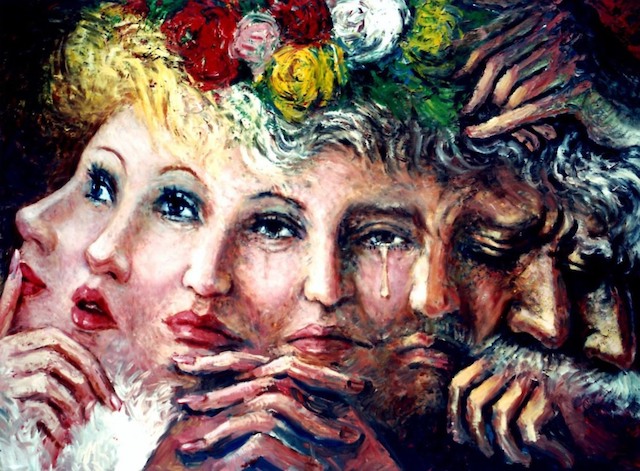
The qualities and characteristics of femininity and masculinity have been debated throughout history and are referenced now more than ever with passionate opinions as varying social and gender movements have made their impact.
Within this article, we will delve into how language creates biased understandings of femininity and masculinity, how the idea of gender imbalance produces biased understandings and assumptive conclusions, and how shame, blame, and societal conditioning influences our relationship to defining ourselves through masculine, feminine, or a percentile of each—ultimately producing a limited perspective of the potential of self and resulting in inauthenticity.
Because society is not built around encouraging individuals to naturally learn through their own internal processes and development, most people need polarity oriented concepts such as masculine and feminine as reference points to self understanding.
This enables the individual to begin to create a foundation of self understanding of themselves in relation to this singular spectrum of measurement, but it also develops a foundation based on the belief that we need externalized ideas to measure ourselves against as a point of comparison to create a sense of security in the world. Ultimately, it is a singular form of expression which cannot live up to our full potential of human expression.
In a similar vein, attributing behaviors based on labeling people as feminine or masculine is the equivalent to saying the reason why a person committed a crime is because they are a terrorist. This statement simply cannot convey an accurate description of the multiple factors related to why they committed the crime.
Other factors ignored in this singular categorization of the etiology of this situation include:
- The quality of environmental factors which influence a person.
- What the person’s childhood was like.
- How fear, arrogance, and assumptions on the correct way to live influences their viewpoint, i.e., conditioned by adults into religious extremism (the adults are assuming that they are teaching their child the “correct way”).
Another topic in this discussion is the topic of gender imbalance or more accurately, our perception of imbalance. This is the idea that there is too much masculine or feminine energy in the world today and that one is overpowering the other. Various social movements, such as, feminism, as well as social recognition of differing personal identification labels relating to gender expression, and/or sexual preference, such as, queer, transgender, lesbian, gay, and bisexual have brought about awareness and conversation over many relevant sex and gender topics, but for this article we will focus on the topic of gender imbalance.
Gender imbalance can refer to either an overall societal imbalance of feminine and masculine energy, or an imbalance of these energies within an individual.
I would like to raise the question: Is there really gender imbalance or is there an assumption of imbalance? Do we or do we not live in a self regulating system? These questions determine our perception of balance or imbalance and influence our entire outlook. Assumptions without a complete understanding of the system we are analyzing is a form of arrogance and self righteousness which muddles a clear interpretation of the world, just as equally as extremist religious beliefs.
The term gender imbalance itself represents a definitive statement. It disregards that polarity is within everything and is a phenomenon that is taking place all the time. Polarity encompasses both sides of the yin-yang, the Chinese symbol of two opposite universal forces intertwined within and encompassing all opposites—including feminine and masculine. One relational law of the yin-yang is that at the peak of yin it transforms to yang, and at the peak of yang it transforms to yin.
Perhaps, a less assumptive and biased perspective would be to make less definitive statements about the entirety of the system, and allow the natural process of the pendulum to swing to their respective sides. For people to appreciate both sides of the spectrum, they both need to exist in extremes for a certain period of time. For people to believe that some form of change is necessary, trauma and tragic events take place.
Perhaps this seemingly cruel and unpleasant human experience is a necessary one which is entirely in balance as it invokes the energy of its opposite (compassion). Another example is that through a temporary period of time, what is perceived as excessive masculine energy dominating society gives birth to social movements involving gender expression which brings forth not only feminine energy but also societal awareness of gender identification. Lastly, even amongst the extremes there are those individuals who embody more of a balanced composite of the two energies. Thus, the question remains, do we exist in a self regulating system, and if so, are we really ever out of balance?
Next, I would like to bring to light how dynamics of guilt, shame, and blame play a role in the development of the need for categorical expressions. To be specific, I have included the following examples:
Example 1: Men are supposed to be cool and calm and not illustrate emotions. If they act in this way they are being feminine. When a young boy is overly emotional he is often shamed by his father or other male adult figures.
Example 2: Women who aggressively work toward their careers and participate in contact sports are embracing masculine qualities and not embracing their feminine qualities.
These statements assume a level of blame, shame, and guilt as they are blanket statements that are broad and in no way work for every individual. Some people gravitate more toward so-called feminine or masculine expressions of being, which, if were unnatural, wouldn’t exist. It is only through a societal assumption to correct this perceived imbalance that we quickly move back to an assumptive and therefore inaccurate interpretation of reality.
Even the use of the words masculine and feminine in relation to behavior illustrates how creationism is built into our language. For example, “I made this matcha.” This creates bias and produces a narrative that we are the ones who do everything, that we can take credit for where it is grown, how it was packaged and getting it here. Although this is a subtle, and perhaps anal, example, it illustrates how our language itself can paint pictures which are not fully true of the entirety of the situation and therefore remove us from a place of honesty in relation to interpretation, expression, and identification.
Oftentimes, people say things such as, “If we just balance the masculine and feminine polarity, then the world will be a better place.” This statement assumes that the world is out of balance. In addition, the concept of balance is different to everyone. How can any one person truly know that the sex polarity is imbalanced when they don’t know every single person on the planet nor could they perceive the exact percentage of masculine to feminine energy within them? This is another example of how language can easily create an inaccurate statement and produce biased perceptions.
A large amount of human suffering is based on the inability to recognize that both hierarchies of masculine and feminine assume that you need external concepts to tell you how to act, most likely due to a past experience of shame, blame, guilt and societal conditioning.
What if no one has it figured out?
Instead of operating from other people’s concepts of masculine and feminine expressions, what if we just tried to be ourselves without comparing ourselves to these concepts and not being afraid of feeling judged? This would be an attempt to be who we truly are without the need to cling to societal produced expressions and expectations which lead astray our perception of self from our authentic and natural expression.
Hopefully you have found some insight in analyzing the etiology of human perception of masculine and feminine, how our language paints biased conceptual understandings of feminine and masculine ideas, how the concept of gender imbalance produces biased perceptions, and how the concepts of feminine and masculine are ultimately limiting the fullest expression of our true nature resulting in inauthentic concepts of self, that are more liken to expressions of fear, shame, blame, guilt, and societal conditioning.
~
~
~
Author: Brandon Gilbert
Image: Wikicommons
Editor: Travis May











Read 0 comments and reply